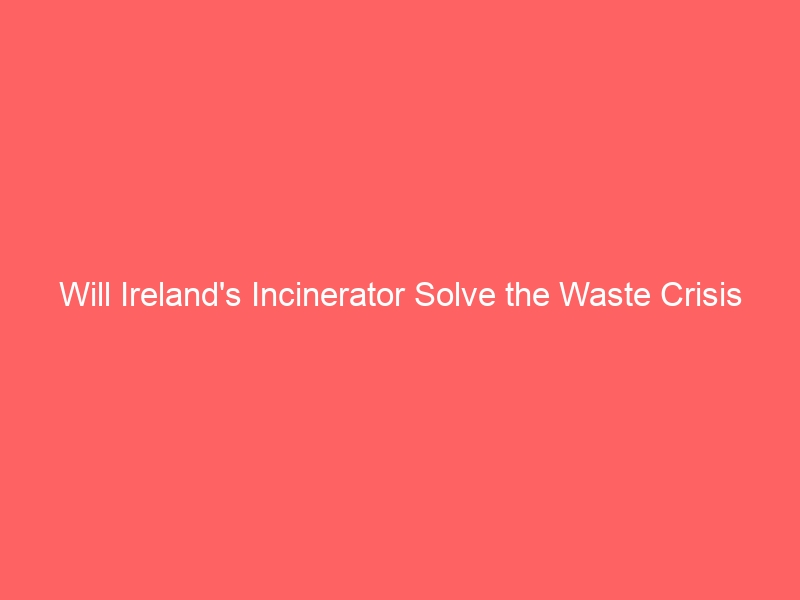Will Ireland’s Incinerator Solve the Waste Crisis or Cause More Problems?
Ireland has been facing a waste crisis for quite some time now. The country produces an enormous amount of waste every year, and the current methods of waste management are simply not enough to handle the increasing volume of garbage. In recent years, the idea of building an incinerator has been proposed as a potential solution to the waste crisis. However, the prospect of building such a facility has sparked a heated debate among the public, with concerns about the potential environmental and health impacts of incineration.
Proponents of the incinerator argue that it is an effective and efficient way to reduce the amount of waste going to landfills, while also generating energy as a byproduct. They claim that incinerators can significantly reduce the volume of waste and minimize the environmental impact of landfilling. On the other hand, opponents of the incinerator argue that it will only lead to more pollution, health risks, and even more waste problems in the long run.
So, will Ireland’s incinerator solve the waste crisis, or cause more problems? To answer this question, let’s take a deeper look into the issue and explore both sides of the argument.
The Case for Incineration:
Incineration is a process of burning waste at high temperatures to convert it into ash, flue gas, and heat. This heat can then be used to generate electricity, providing a valuable energy source. Proponents of incineration argue that this process can significantly reduce the volume of waste going to landfills, which in turn can help in addressing the waste crisis.
Moreover, incinerators are equipped with state-of-the-art pollution control systems that can capture harmful emissions and particulate matter, ensuring that the process is environmentally friendly. This means that incineration can help in reducing air and water pollution, which is a major concern associated with traditional landfilling.
In addition, incineration can also help in reducing greenhouse gas emissions. When waste decomposes in landfills, it releases methane, which is a potent greenhouse gas. By incinerating the waste, the release of methane can be minimized, thus contributing to the reduction of greenhouse gas emissions.
The Case Against Incineration:
However, opponents of incineration argue that the process poses significant health and environmental risks. They claim that incinerators release toxic pollutants such as dioxins, heavy metals, and other harmful chemicals into the atmosphere, which can pose serious health risks to nearby communities.
Furthermore, incineration generates ash which contains toxic substances, and disposal of this ash can lead to environmental contamination. There is also the concern that incinerators can create a disincentive for waste reduction, recycling, and composting, thus perpetuating the culture of excessive waste generation.
Moreover, opponents argue that incineration is not a sustainable solution to the waste crisis. Instead of addressing the root causes of the problem, incineration only perpetuates the cycle of waste generation, and may lead to even more waste being produced in the long run.
FAQs:
Q: What impact will the incinerator have on air quality?
A: Proponents argue that incinerators are equipped with advanced pollution control systems that capture harmful emissions, thus minimizing the impact on air quality. However, opponents point to the potential release of toxic pollutants and the health risks associated with incinerator emissions.
Q: Will the incinerator contribute to reducing greenhouse gas emissions?
A: Incineration can help in reducing methane emissions from landfills by diverting waste from landfilling. However, opponents argue that the process releases carbon dioxide and other greenhouse gases, and may not be a sustainable solution to reducing overall emissions.
Q: Is incineration a cost-effective solution for waste management?
A: Proponents argue that incinerators can generate energy, thus offsetting the cost of waste management. However, opponents point to the high initial cost of building and operating an incinerator, as well as the long-term environmental and health costs.
Q: What are the alternatives to incineration for waste management?
A: Alternatives to incineration include reducing waste generation, increasing recycling and composting, and investing in sustainable waste management technologies such as anaerobic digestion and waste-to-energy facilities.
In conclusion, the debate over whether Ireland’s incinerator will solve the waste crisis or cause more problems is complex and contentious. While incineration has the potential to reduce the volume of waste going to landfills, generate energy, and minimize environmental impacts, it also raises significant health and environmental concerns. Ultimately, the decision to build an incinerator in Ireland will require careful consideration of the potential risks and benefits, and a comprehensive evaluation of alternative waste management strategies.
Will Ireland’s Incinerator Solve the Waste Crisis or Cause More Problems?




